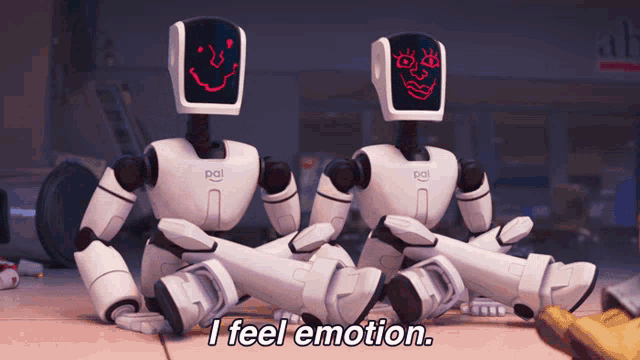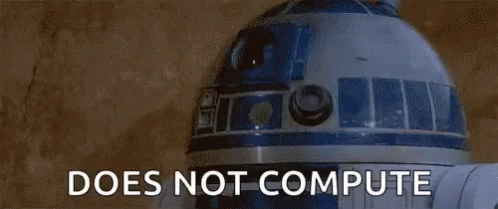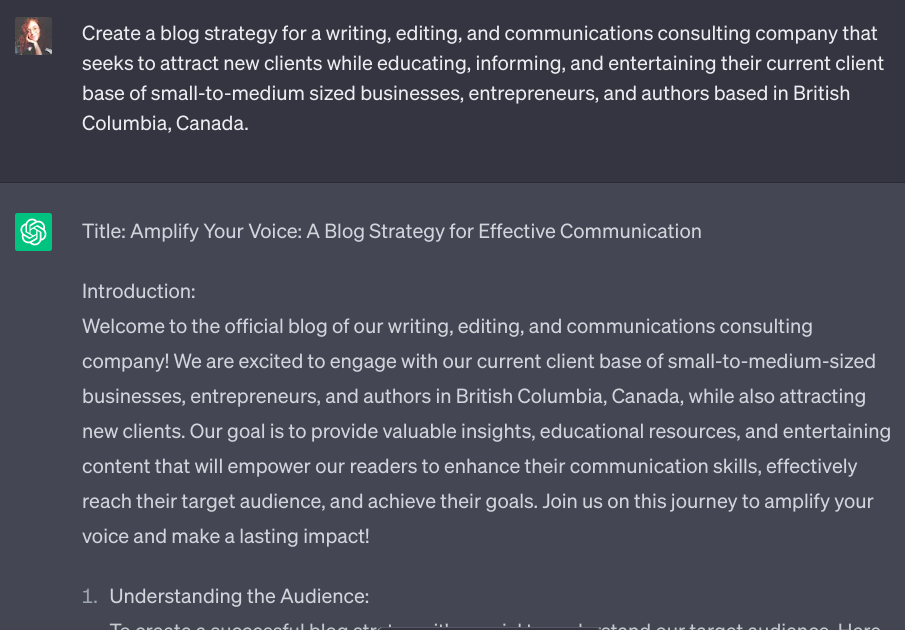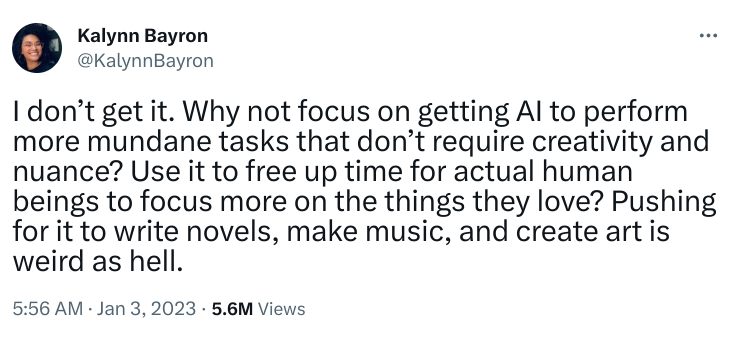Blogging in the Age of AI: Can’t the Robots Do That Now?

Keeping up a regular blog seems like it should be as natural as breathing for a writing/editing company — a basic rite of passage. And with generative AI growing by leaps and bounds, you may even think, “Can’t the robots do that now?”

We kicked off The Block Party one year ago, in June of 2022. (Happy birthday, The Block Party!) This was right before ChatGPT entered the picture, allowing students to take a breath while the bots wrote their essays, and sending writers spiralling into existential dread with questions about job security.
We’ll circle back to that later, but to start we’d like to acknowledge just how much goes into a blog aside from writing the actual posts.
WRITE THE CODE
Let’s get the obvious out of the way first: to run a successful blog, you need an audience. (That’s you — thanks for being here.) When we kicked off The Block Party, we were confident there was at least one person out there as nerdy as we are who wants to read about editing, storytelling, and an abundance of cat puns. Reaching that person is where the work came in.
Every blogger dreams of seeing their latest post rank #1 on a quick Google search. But the average blogger isn’t going to spend enough money to make sure Google puts them there. Who even has that kind of cash? So, in order to do the next best thing for online visibility, we had to get creative.
We had to have a strategy.
To a daydreaming, word-loving, math-averse writer such as myself, there’s nothing quite so horrifying as a word like strategy. Strategy involves planning. Planning involves outlines, estimations, and deadlines. That’s already getting too close to numbers for my liking — no, thank you! But as I learned through the trial and error of writing a fantasy trilogy without an outline, flying through projects by the seat of my pants and expecting a consistent, logical outcome is a flight of fancy.
Much like a story outline establishes the beginning, middle, and end, a blog strategy should outline the story you’re trying to tell and who you’re trying to reach, as well as the best ways to get your message across. It is the roadmap you don’t want to start your adventure without. Trust me.
To put it another way: your blog strategy is the code that programs how the whole operation works. Like any software, without the code running in the background to dictate how each button and feature functions, nothing would work. Your blog strategy should specify a thoughtful posting schedule, suggested lengths for each post or type of post, the types of content that will communicate your ideas most clearly, and more.
UPDATE YOUR SOFTWARE
”The best laid plans of mice and men often go awry.” —To a Mouse by Robert Burns
Plans and deadlines are helpful for creating consistency and structure. But rigid dedication to them will get you into trouble because they’re just guesstimates — guidelines. We can’t predict the future (yet 🤖), so if we set out to do something a certain way, there’s no guarantee it will make sense to stick to that plan when unexpected twists and turns come up.

The world changes faster than we can predict. The key to an effective strategy is flexibility and the willingness to shift content around if — for example — a relevant event pops up in the news, or a collaborator approaches you with an exciting but time-sensitive opportunity.
Reacting well to new information, rather than remaining stuck in expectations framed by outdated information, is a crucial skill — not only for writing, but for life. When the parameters change, we must learn how to adapt, rather than shutting down or frying our own circuit boards with stress and frustration. Luckily, our internal programming isn’t locked behind some master password we can’t remember — we can teach ourselves new habits. The bots’ve got nothing on us!
WORK OUT ALL THE BUGS
While we’re busy giving advice, let’s borrow from some age-old wisdom: Work smarter, not harder. Does that mean I’m saying yes to the question “Can’t the robots do all that by now?” so I can automate my career and retire at the ripe old age of 26?
Let’s address that.
Generative AI has been proven capable of copywriting — blog posts, short romance narratives, and social media post captions, for example. ChatGPT was recently co-credited for writing an episode of the TV show South Park. And guess what? It can even generate full-on blog strategies.

For the full version, visit https://chat.openai.com/share/af7800fa-da32-4a18-a58c-6f0128a41610.
While generative AI is capable of spitting out an impressively concise strategy outline for any blog you might see around the web, someone still has to condense the specifics of their particular business into prompts, to generate the right topics for the right audience. That done, someone will need to craft more prompts to generate the actual blog posts that fit those topics. And even if those posts are seemingly usable, someone still has to edit whatever the AI comes up with because — and verdict.co.uk said it best here — “Generative AI programs like ChatGPT generate prose, not facts.”
Expecting generative AI to provide accurate information is like asking a four-year-old if they know how gravity works and expecting a factual response. I.e., they may be bullshitting you with a completely straight face (not-so-affectionately referred to as “hallucinations” by the tech industry). The problem, as shown by the professor that tried to fail his entire class based on ChatGPT’s insistence that it had written all their essays, is that it’s harder to fact-check a bot’s output than the ramblings of a human child. Especially for the average person who likely doesn’t fully understand what generative AI can and cannot do.
NEVER STOP OPTIMIZING
In a society obsessed with individuality, relying entirely on a bot that condenses the most popular data on the internet to reproduce content doesn’t exactly scream originality. As our blog strategy example from ChatGPT shows, the bots’ blogging strategies look just like everyone else’s.
Finding our unique voice and capitalizing on our quirks as a team is one of our favourite things about the whole blogging operation, so we’re not about to stop now. But true to form, we’re adapting too. From introducing ourselves as the (not so) new kids on the block to kicking off our What the Heck Do We Do? Series, this little but mighty blog has seen some things. We’ve adapted our deadlines and topics as things came up, like that time we covered the 2023 Blizzard Music Festival, or when child-author Holly Talbot published her second book. We’ve drafted case studies, shouted-out cool collaborators, and basked in the sublime glory of other people’s words.
While we’re still learning in the evolving technological landscape around us, one thing has not changed: we love stringing words together for you to digest. Your trust in us, your cheers of encouragement, and your heartwarming engagement with our work plays an integral role in our success. We don’t want to take you for granted. We’ll keep adapting, adjusting, and improving so that we can bring you the best material possible. Because if we don’t do that, we let the bots win.

And they’re just not ready for that yet.


